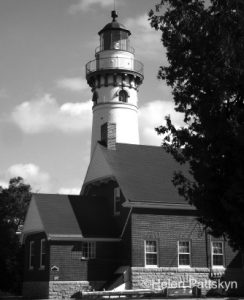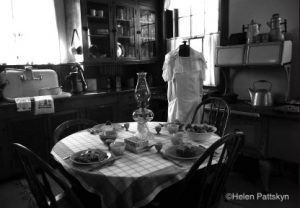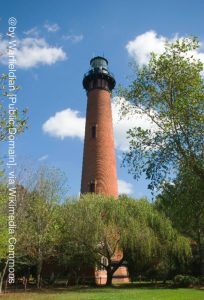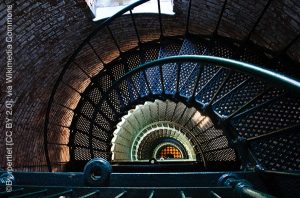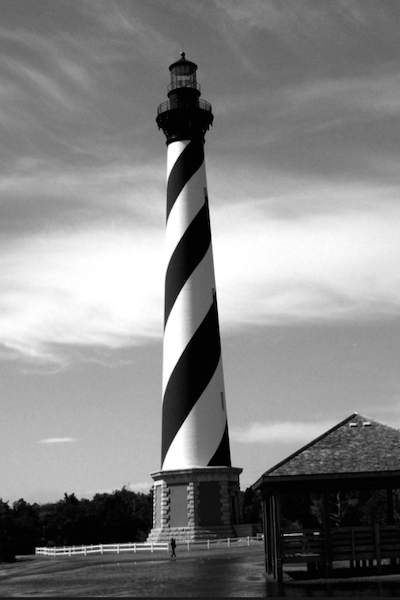 Paranormal researchers have to be ready for any- thing and everything when ghosthunting. They often deal with weather issues, equipment failures, and physical challenges as they’re tromping through dense woods and other rough terrain.
Paranormal researchers have to be ready for any- thing and everything when ghosthunting. They often deal with weather issues, equipment failures, and physical challenges as they’re tromping through dense woods and other rough terrain.
Walking through the battleship USS North Carolina is a bit of a maze, and it’s hard work climbing up and down the iron ladders that are euphemistically called “stairs.” As I was moving through the ship, it was readily apparent that trying to bring a film crew on board to run cables throughout the ship would be quite a task. Shows like Ghost Hunters have an established crew that sets up the monitors, cameras, and equipment, hoping to catch paranormal activity on film. They’ve visited the USS North Carolina, and I can imagine how hard the TV crew had to work in order to prepare for that investigation.
After the USS North Carolina tour, I headed out to see the Cape Hatteras Lighthouse. If you’ve ever been to North Carolina, you’ll recognize it as the state symbol, painted in a signature swirl of black and white. It’s quite spectacular to see firsthand. Some people describe it as the biggest barber pole they have ever seen.
I like the swirl-style painting of the lighthouse. It’s one of those things that I call a happy accident. The lighthouse was supposed to have been painted in a diamond pattern, but the engineer was confused by the plans and he designed the spiral instead, making the lighthouse very distinctive. The lighthouse was built to warn sailors of the Diamond Shoals, which are sandbars that shift often and can extend more than 14 feet outward from the shore at Cape Hatteras. In addition, it is in this area of the Atlantic that the Gulf Stream collides with the colder Labrador current. Often, the end result of the collision between the warm Gulf current and the cold Labrador current is the creation of powerful ocean storms and high sea swells. These sandbars and tricky currents have sunk many ships and given North Carolina the nickname “Graveyard of the Atlantic.”
When you arrive at the Cape Hatteras Lighthouse, the first thought that hits you is how tall it is and how small you feel standing next to it. The second thought is that you want to climb it! It’s there, it must be climbed, and the view from the top is a must-see.
The lighthouse has 248 iron stairs arranged in a spiral. Climbing to the top of the lighthouse is equivalent to climbing a 12-story building. It’s noisy, as many people are climbing to the top with you. Their shoes clang on the iron steps, there’s no air-conditioning, and it gets pretty hot and sticky fast. There are a couple of windows in the lighthouse, but for the most part, the lighting is dim. As you continue the climb, you encounter people coming back down, and there’s a bit of a tussle, as there is only a handrail on one side to hold onto. You become very friendly with strangers as you negotiate to allow them to pass by you. Luckily, there is a landing every 31 steps to stop and wait when large groups are coming down.
I visited during the day to see the lighthouse, and I have plans to return again this summer when a full-moon climbing tour is offered. This is a must-do, as the view from the top is spectacular. I look forward to seeing it on a moonlit night.
 In 1999, the lighthouse was moved from its original location. Wow! Can you imagine the engineering feat it took to move a lighthouse? Erosion from the waves and shifting sands threatened to destroy the lighthouse in its former location, and the decision had to be made to either attempt to move the lighthouse to safety or to watch it disappear as the sand shifted and the ocean claimed it as its own. The lighthouse, along with the keeper’s house, was moved to a new location 2,900 feet away. This process took a painstakingly slow 23 days to complete.
In 1999, the lighthouse was moved from its original location. Wow! Can you imagine the engineering feat it took to move a lighthouse? Erosion from the waves and shifting sands threatened to destroy the lighthouse in its former location, and the decision had to be made to either attempt to move the lighthouse to safety or to watch it disappear as the sand shifted and the ocean claimed it as its own. The lighthouse, along with the keeper’s house, was moved to a new location 2,900 feet away. This process took a painstakingly slow 23 days to complete.
Given that the lighthouse has been the guardian to the Graveyard of the Atlantic, it’s no surprise to find that it’s also extremely haunted.
One haunting tale is the story of the Carroll A. Deering, a sailing ship that was returning from Barbados on its way to Hampton Roads, Virginia. On January 31, 1921, the Carroll A. Deering was found run aground on the Diamond Shoals off the coast of Cape Hatteras. The ship was a five-masted schooner built in 1919 in Bath, Maine. The Coast Guard was called, and guardsmen sailed out to inspect the ship, which was found empty with the exception of several very hungry cats. The investigation found that a dinner had recently been prepared and the dishes were still on the table. The ship was in good order, but the lifeboats were missing.
What would cause the captain and crew to abandon the ship in such a hurry when the ship was in good working order? Why would they leave their cats behind? The research indicates that the crew left in a panic, as if they were afraid of something on the boat. Along with their dinner, they left a perfectly good boat in running order. They didn’t even stop to lower the sails on the boat. There had to have been something extreme to cause a captain and his crew to leave a ship in that condition, especially when they were facing freezing cold weather and high sea swells in January on the Atlantic Ocean.
Upon further investigation, the Coast Guard found that all of the anchors were missing from the ship, along with some papers and personal belongings of the captain and crew. The vessel remained stuck on the shoals until it was towed away in March. What remained of the ship was blown up with dynamite. I found that fact surprising: Why would evidence of an unsolved mystery be deliberately destroyed? In addition, why wouldn’t any part of the ship be salvaged for future use elsewhere?
Reports state that in April of the same year, a North Carolina resident found a bottle washed up on shore with a note inside stating that the captain and crew had been captured by pirates. The letter was later determined to be a hoax.
The following month, the wife of the ship’s captain visited Washington and asked then–Secretary of Commerce Herbert Hoover to investigate what had happened to her husband and his crew. He agreed to look into the matter after his research showed that nine other ships had also disappeared in the same area. The FBI was sent to investigate the matter in July 1921. The investigators returned with reports stating theories of foul play, including attacks by pirates, attacks by rumrunners, and the possibility of mutiny.
The theory of mutiny was tossed aside. The seas are so rough in that part of the Atlantic in January that it would be a suicide mission by the crew and the worst timing on their part. The ship was only a day or two away from reaching Virginia, where it was scheduled to dock. Regardless of the circumstances, it’s highly unlikely that a crew would have picked this vantage point where so many ships are known to wreck. In addition, a mutinous crew would have tossed the captain overboard and most likely would have continued on with the ship, sailing to a port in another country.
Foul play with pirates or rumrunners also seemed unlikely, as there were no dead bodies left on the ship, as well as no signs of struggle or blood. The ship’s log, the lifeboats, and the navigation equipment were missing and never found. Although there was a detailed investigation, all of the leads turned up empty. To this day, the mystery continues.
After the ship ran aground, witnesses in the area began reporting hearing people screaming for help near the shore. The reports state that when witnesses hear the screaming, they go to investigate, but no one is ever seen. Some of these reports say that several people have heard a man scream over and over that a monster is coming for him.
Some locals think that a ghost appeared on the ship, perhaps one of the pirates from the many sunken ships that lay below the ocean near Cape Hatteras. Perhaps these pirate ghosts boarded the ship as the crew prepared their dinner and scared them out of their minds, to the point that they jumped into the lifeboats and abandoned ship, leaving everything behind. In their fear and perhaps demise, it appears that they now have joined the ghosts and walk the beaches beside them.
The most famous ghost on Cape Hatteras is the Gray Man ghost. He appears to people to warn them when a hurricane or severe storm is heading toward the island. Some say that he is a sailor who drowned during a storm and now warns others of impending storms. Others say that he was in love with a local girl and in his haste to get back to her took a shortcut with his traveling companions through a swampy area and drowned in quicksand.
The legend states that the local woman was devastated upon hearing the news of his death. Each night for weeks she walked the beach in sorrow and grief. One night as she walked along the beach, he appeared to her as the Gray Man ghost and told her that she needed to leave immediately because a hurricane was coming. She ran home and told her family, who believed her, and they left immediately and went inland.
The next morning a hurricane hit the island and destroyed many of the homes there, but her home was spared. The legend states that if the Gray Man appears to you and you heed his advice to leave, then your house will be spared by the storm. Reports continue to be shared by locals who say they have seen the man appear before them out of thin air. He warns them of an approaching storm and then quickly disappears.
Other reports include seeing a strange-colored brown pelican in a ghostly form that appears to warn locals about incoming storms. Some say that the phantom bird may be a companion of the Gray Man.
There are also reports of a dark lady of Spanish descent, dressed all in black, who walks along the shore by the lighthouse. Her clothes are wet and hang on her body. By most accounts, it appears that she drowned in a shipwreck. Most reports state that she is angry and is looking for something that she never finds. At times it appears that she screams and wails like a banshee. Perhaps she’s searching for a lost treasure or her jewels that were lost at sea. She is often seen on full-moon nights, and I imagine that the view from the top of the lighthouse might provide a vantage point to search the surrounding shore for ghosts walking along the beach.
Shadow people are also reported appearing in the vicinity of the lighthouse and inside on the stairs of the lighthouse. Some paranormal researchers think shadow people may be a specific type of ghost, while others surmise that they are malicious entities traveling from the various supernatural realms into the earth plane.
Shadow people are not considered to be friendly, and when they are seen, they often do not have faces. They appear in a human shape but are not completely formed. The two most popular theories about the shadow people fall into two camps: One is that the shadow people are thought-forms, which are created when deep trauma has occurred in the area and the emotional intensity is so strong that it gives life to a thought form, a tulpa, which then haunts the area.
The other theory is that they are not from this world but are attracted to areas where negative experiences have caused a great amount of trauma and pain. They enter the earth plane to feed on the energy of this trauma and the energy from grieving victims. For this reason, shadow people are often seen in cemeteries.
Given the hundreds of shipwrecks around Cape Hatteras Lighthouse and the Diamond Shoals and the ghosts who walk the beach, many of whom still lay in their physical form under the sea in sunken ships, the entire area is a restless place and ripe for paranormal activity.
In addition, there are many reports of unmarked graves in the area around the lighthouse, leading to the potential for other undocumented ghosts, as well. While walking around the lighthouse and the shore, you can feel the sadness in the air. You don’t earn the nickname Graveyard of the Atlantic without having more than a few ghosts around with unfinished business, some looking for their treasure, some trying to escape what horrified them, and others, like the Gray Man, trying to protect the local residents from further harm.
For more haunted stories, check out Kala Ambrose’s book Ghosthunting North Carolina.
